THE OLYMPIAN

Fall Issue 2014 C E l E bra T ing THE 30 TH a nniv E rsary Of THE 1984 g am E s

MOTTO: ONCE AN OLYMPIAN; ALWAYS AN OLYMPIAN NEVER FORMER; NEVER PAST ®
a l etter f rom g ary Hall, s r.
U.S. Olympians and Paralympians Association President

Dear U.S. Olympians and Paralympians,
First, I want to thank all of you who registered for Olympic Day 2014. Olympic Day celebrates the founding of the modern Olympic Games each June and it is a wonderful opportunity for all of us to foster Olympism and encourage youth across America to participate in our Olympic sports programs. This year Olympic Day was a resounding success! 1,055 Olympic Day events were registered and 892 Olympians and Paralympians combined registered to participate. 2014 was a paramount success - making this year the most successful Olympic Day celebration in United States history.
Congratulations go to track & field, swimming, rowing and speed skating who had the most athlete participation. It was a great team effort, as 20 different Olympic and Paralympic sports were represented at Olympic Day. Most of all, congratulations go to Adam Andrasko and his team at the USOC for helping to organize all of these events.
I also want to thank all of the Olympians and Paralympians that participated in the World Fit Walk 2014. World Fit is the fitness initiative that was founded by the USOA in 2005 to help promote fitness and improve health among America’s youth. This year, 33 schools participated in the Walk with 13,559 students logging in 1,117,405 miles over the six-week program.
Congratulations go to World Fit Dallas, led by Olympians Sammy Walker and Janine Bowman, where 7 schools participated and World Fit Lexington, led by Olympians Micki King and Passion Richardson, where 9 schools participated. National Champion schools in 2014 were John B. Hood Middle School in Dallas (large school division) and L’Etoille French Immersion School in Portland (small school division). The students from John B. Hood averaged 7.0 miles per student per day for the 40 days, while the students from L’Etoille (first, second and third graders) averaged 5.8 miles per student per day.
I am also pleased to inform you that the World Olympians Association has elected to make World Fit one of its four pillar programs for the next Quadrennium. Under CEO Mike Miller, the WOA
is currently seeking a corporate partner that will financially support the growth of World Fit globally.
Later this month, the Chapter Presidents and Officers of the USOPA will convene in Chicago at the 2014 U.S. Olympic and Paralympic Assembly. Congratulations to our three newest Chapter Presidents, Dean Willeford (water polo, 1968) in Nevada, Carrie Zimmerman (gymnastics, 1976) in Florida and Jackie Washington (track & field, 1984) in Houston. All will be in attendance.
At the Assembly, we will continue our quest to better organize and serve all of you, and we shall seek ways for you to become more involved and connected to the USOPA. The pride we all felt by qualifying to represent our country at the Olympic or Paralympic Games never really goes away. In fact, I think it continues to swell throughout our lives.
The USOPA is comprised of members that are among the most influential and powerful people in America. Collectively, when we put our effort behind the right events and causes, we can change the world in a positive way. That is what Olympism is all about.
Yours in Olympic Spirit,

Gary Hall, Sr.
U. S. Olympians and Paralympians Association President
i nside 2 A Letter from Gary Hall, Sr. 4 30th Anniversary of 1984 Games 7 Archives & Archivist 8 Captain America Tim Howard 9 Athlete Career & Education (ACE) Program 10 Olympic Champions 12 Echo Summit – Memories Relived 14 Olympic Day 2014 15 Alumni In Honor 16 Liberty Mutual 17 Alumni In Memoriam 23 Olympian & Paralympian Photo Highlights 24 U.S. Olympians & Paralympians Chapters Cover image: Los Angeles 1984 Olympic Games, Opening Ceremony. Ed Burke (track & field) flag bearer for Team USA, marching in the parade of athletes. (Photo by DUOMO/PCN ) THE OLYMPIAN NEWSLETTER 3

R AFER J OHNSON OF THE U.S. HOLDS THE O LYMPIC TORCH AFTER LIGHTING THE O LYMPIC FLAME AT THE CLIMAX OF THE O PENING C EREMONIES FOR THE 1984 O LYMPIC G AMES AT THE COLISEUM IN L OS A NGELES .

 Paul Gonzales Jr., of the U.S. stands above silver medalist Salvatore Todisco of Italy on the podium and celebrates winning the men’s light-flyweight boxing final on Aug. 11, 1984, during the XXIII Olympic Games at the Los Angeles Memorial Sports Arena in Los Angeles.
Carl Lewis of the U.S. raises his arms aloft as he crosses the line to anchor the U.S. team to victory in the 4x100-meter during the Los Angeles 1984 Olympic Games at the coliseum on Aug. 11, 1984.
Paul Gonzales Jr., of the U.S. stands above silver medalist Salvatore Todisco of Italy on the podium and celebrates winning the men’s light-flyweight boxing final on Aug. 11, 1984, during the XXIII Olympic Games at the Los Angeles Memorial Sports Arena in Los Angeles.
Carl Lewis of the U.S. raises his arms aloft as he crosses the line to anchor the U.S. team to victory in the 4x100-meter during the Los Angeles 1984 Olympic Games at the coliseum on Aug. 11, 1984.
4 THE OLYMPIAN NEWSLETTER
lOs angElEs CElEbraTEs 30th annivErsary Of 1984 gamEs
By: Amy Rosewater
Thirty years after he lit the cauldron to kick off the 1984 Olympic Games in the Los Angeles Memorial Coliseum, Rafer Johnson easily walked through the grounds at the LA84 Foundation and handed off a torch to Peter Ueberroth, followed by LA84 Foundation President Anita DeFrantz. The ceremony took place in front of about 250 guests, nearly 50 of them Olympians and many of which were athletes that had competed in 1984.
The anniversary moment was a walk in the park compared to Johnson’s job 30 years ago. Back on July 28, 1984, he had to traipse up 99 steps with the flame and ignite the cauldron in front of a crowd of about 90,000 in the same

stadium that hosted the Los Angeles 1932 Olympic Games.
“It was pressure,” Johnson said. “I was full of nerves and my heart was beating so fast that I could feel it beating in my
but on July 28, 1984, Johnson was able to relax and mingle with the athletes who made the 1984 games so memorable.
forehead. It really was an unbelievable experience. There is nothing like it.”
But on July 28, 2014, Johnson was able to relax and mingle with the athletes who made the 1984 Games so memorable. Among those who attended

the milestone celebration were gold medalists Edwin Moses (track and field), Mary Lou Retton (gymnastics), Greg Louganis (diving), Connie CarpenterPhinney (cycling), Rowdy Gaines (swimming) and Paul Gonzales (boxing). Ueberroth, who spearheaded the 1984 Games and is credited for getting the Olympic Movement back on track, came to the ceremony with his wife, Ginny.
The 1984 Opening Ceremony in Los Angeles indeed was the start of something very special for the United States, especially when one considers the incredible moments that would follow throughout the 16 days of those Games.

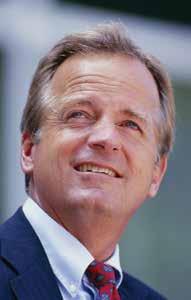
THE OLYMPIAN NEWSLETTER 5
Diver Greg Louganis of the U.S. in action at the pool.
Mary Lou Retton became the first American woman to win the gymnastics all-around gold medal.
Joan Benoit of the U.S. in her victory lap after winning a gold medal in the marathon at the Los Angeles 1984 Olympic Games.
Peter Ueberroth spearheaded the 1984 Games.

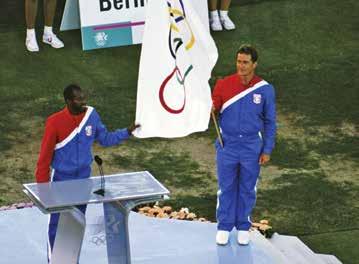

The U.S. 4x100 swim team listens to the national anthem after receiving the gold medal at the Los Angeles 1984 Olympic Games. The U.S. team consisting of Chris Cavanaugh, Matt Biondi, Michael Heath and Rowdy Gaines won gold in a world record time of 3:19.03.
The U.s. dominated the competition, capturing 83 gold medals, 61 silver medals and 30 bronze medals for a total of 174 medals in Los Angeles. The U.S. garnered 197 medals when the Games were held eighty years earlier in St. Louis (62 golds, 66 silvers and 69 bronzes).
Despite the fact that several Eastern bloc countries boycotted the Games in Los Angeles, a record 140 nations participated in the 1984 Games, with more than 7,000 athletes competing.
american women shined in several new events, as Joan Benoit won the inaugural Olympic women’s marathon, Connie Carpenter-Phinney and teammate Rebecca Twigg finished 1-2 in the first Olympic women’s cycling road race, while rhythmic gymnastics and synchronized swimming debuted on the Olympic program.
memorable american performances include Greg Louganis capturing his first two Olympic gold medals, Mary Lou Retton becoming the first U.S. woman to win the gymnastics allaround gold medal, Edwin Moses winning his second gold medal in the 400-meter hurdles and Carl Lewis becoming the second American track athlete to win four gold medals in one Olympic Games (Jesse Owens captured four in 1936).
americans won nine of 12 gold medals in boxing, both the men’s and women’s basketball gold medals, nine wrestling gold medals, including seven in freestyle and two in GrecoRoman, and 21 gold medals in swimming.
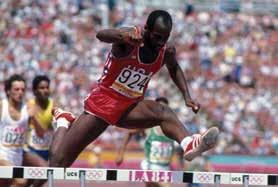
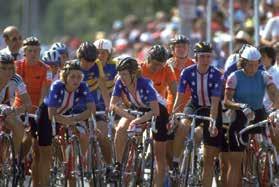
6 THE OLYMPIAN NEWSLETTER
Edwin Moses of the U.S. clears a hurdle en route to his victory in the men’s 400-meter hurdles final at the 1984 Games in Los Angeles.
Los Angeles 1984 Olympic Games, Opening Ceremony. Edwin Moses (track & field) reciting the athletes Olympic Oath.
Los Angeles 1984 Olympic Games, Team USA Opening Ceremony. ( photo credit: Paul J. Sutton/DUOMO/PCN)
The U.S. Women’s Road Race Cycling Team prepare for the race to begin. Left to right is Rebecca Twigg, Connie Carpenter-Phinney and Janelle Parks.
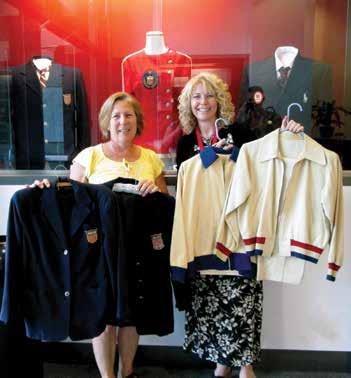
actually crossing the threshold. The display will feature items that capture the Olympic Movement in the U.S., such as a recent donation from Judy Schreiber, the daughter of Clara Schroth Lomady. As a U.S. gymnast, Clara is a two-time Olympian (London 1948 and Helsinki 1952 Olympic Games), and was a member of the team that brought home the bronze medal in the women’s team all-around at the 1948 Games.
archives not only values and preserves, but also displays this type of donation. Judy, along with archivist Teri Hedgpeth, stood and admired a display of historic Team USA parade uniforms, including apparel from the London 1948 Olympic Games (Sammy Lee Collection), Grenoble 1968 Olympic Winter Games (Tina Noyes Collection) and London 2012 Olympic Games (Polo Ralph Lauren Collection). With Judy’s donation of Clara Schroth Lomady’s uniforms, the display now features both the men’s and women’s parade uniform from the 1948 Games.
It is our hope that more Olympians will consider the Crawford Family U.S. Olympic Archives and U.S. Olympic Committee as the final custodians for their Olympic artifacts and memorabilia.
The construction of the Crawford Family U.S. Olympic Archives is almost complete and within a few weeks, USOC archives will move the entire collection to its new home at headquarters. We would not be able to build this fantastic facility without the vision and assistance of Gordy and Dona Crawford. Words alone cannot express how excited we are to introduce a state-of-the-art archive in which we can preserve and protect our Olympic history.
One unique feature of our archive is a display cabinet that runs along the outside perimeter of the archives on the second floor of headquarters –over 70 linear feet of visible displays. Visitors to the USOC headquarters will be able to get a wonderful sample of what is held within the archives without
An amazing athlete, Clara dominated women’s gymnastics in the 1940s and early ‘50s by winning six all-around titles, and between 1941 and 1952, she clinched 39 total national titles in gymnastics with 11 consecutive titles on the balance beam. In addition, Clara won a silver medal in long jump at the 1945 Amateur Athletic Union Championships.
Her daughter, Judy, contacted the archives department this past July to see if we were interested in her mother’s Olympic uniforms. We assured her that this is exactly the type of donation we love – one that belongs to a specific athlete and captures the history of that athlete’s endeavors, as well as the overall history of the Olympic Movement.
When Judy brought her donation to headquarters, it was immediately apparent to her how much USOC

Helsinki 1952 Olympic Games, Gymnastics. Clara Schroth Lomady (USA).
THE OLYMPIAN NEWSLETTER 7
, U s OC a r CH ivis T & His TO ri C
Teresa Hedgpe TH
Judy Schreiber (left) and Teri Hedgpeth (archivist) with Clara Schroth Lomady’s 1948 and 1952 Olympic Team USA parade uniform and gymnastics warm ups.
Cap T ain: a meri C a Tim Howard

Olympian and W O rld C U p g O alkeeper be CO mes s OC ial media s T ar af T er 16-save perf O rman C e in b razil
By Brian Trusdell
Tim Howard has received praise for his goalkeeping before.
However, the Photoshop edited images of him as Captain America stopping a meteor that appeared on Facebook and Twitter are new.
“With today’s social media, nothing surprises me,” the U.S. Men’s World Cup Team goalkeeper said with a laugh. “There are a lot of creative, funny individuals out there.”
Howard has been a hero to U.S. soccer fans for his more than a decade as a member of the national team. He earned a lot of new admirers during the 2014 FIFA World Cup, held June 12-July 13 in Rio De Janeiro, particularly in his standout performance with 16 saves that enabled the U.S. to drag Belgium into extra time, before falling 2-1 in the quarterfinals.
Despite the loss, Howard’s 16 saves were the most in a FIFA World Cup since records started being tracked in 1966 – the previous record was 13 saves in 1978.
The Internet quickly was awash in “ThingsTimHowardCouldSave” memes, from catching a meteor to preventing the extinction of dinosaurs, to halting the Titanic from sinking, to keeping Mufasa from dying in “The Lion King”.
“When you’re in the public eye, it’s part of what you have to deal with,” Howard said in regards to the attention. “I’ve been dealing with it for a long time. It’s nice to know that America knows about soccer now.”
Unprecedented attention and television viewership followed the U.S. team throughout the FIFA World Cup.
Public viewing parties drew crowds across the country for the U.S. games, including thousands of people that
showed up in places like New York, Kansas City, Kansas, and Chicago to marvel at Howard’s exploits in the game against Belgium.
“Every four years, America gets behind this team,” Howard said. “We have a good following. I don’t think it’s a bad thing that we get attention every four years. That’s hard to sustain every day.”
Promoting the game of soccer seems to be nearly every American player’s crusade, and has been for decades. The 35-year-old Howard, a native of North Brunswick, New Jersey, who began his professional career with the New YorkNew Jersey Metro Stars (now New York Red Bulls) in 1998 before moving to England five years later, has done more than his share for badge and country.
His 104 appearances is the most for a goalkeeper in the history of the U.S. national team. Howard also ranks 10th most appearances among all players, trailing Eric Wynalda by just two – Cobi Jones currently holds the U.S. record with 164. Howard was the back-up goalkeeper behind Brad Friedel for Team USA during the Sydney 2000 Olympic Games and earned his first senior cap with the U.S. squad in 2002.
With 29-year-old Brad Guzan, a member of the 2008 U.S. Olympic Team, patiently playing back-up goalie for seven years, Howard wouldn’t commit to another World Cup qualifying campaign.
“I signed a four-year contract, an extension with Everton,” Howard said referring to his English club team. “That excites me. It’s all good things, with a club that I love.
“With the national team, I don’t know. The emotions are too raw. I have to sit down and see what the future looks like. I don’t think it’s black and white. I have to sit down and figure it out.”
Before the 2014 FIFA World Cup, Howard
essentially ruled out a return to Major League Soccer – but, he wasn’t saying no to the U.S. national team.
“A lot goes into that decision,” he said. “Right now, emotions are high. Barring injury, I’m willing to keep going, but a lot more goes into that decision than my physical health.”
Howard has already seen the next generation start their trek up the U.S. national team ladder. The U.S. World Cup team was relatively young, and Howard seemed especially impressed by the youngest members, 19-year-old Bayern Munich winger Julian Green, who scored the goal against Belgium, and 20-year-old Seattle Sounders defender DeAndre Yedlin.
“The talent pool is rich,” Howard said. “We had a young team, and even if some didn’t play serious minutes, they will be so much better for it.
“As you saw with Julian Green, who came up with a goal when we desperately needed it, as well as in DeAndre Yedlin, who brings a big smile to my face. He’s a threat to anyone. It’s very exciting for U.S. soccer.”
And if this was Howard’s last FIFA World Cup, he’s happy to let history determine his place among other notable U.S. goalkeepers.
“From a legacy standpoint, that’s for others to decide,” Howard said. “I just keep my head down and work hard. Brad (Friedel), Kasey (Keller), Tony (Meola) and myself, we all know where we each stand. I’m lucky to be in a long line of great goalkeepers.”
Brian Trusdell is a writer from New Jersey. He has covered four FIFA World Cups and six Olympic Games during his more than 30 years as a sportswriter, mostly with the Associated Press and Bloomberg News. He is a freelance contributor to TeamUSA. org on behalf of Red Line Editorial, Inc.
8 THE OLYMPIAN NEWSLETTER
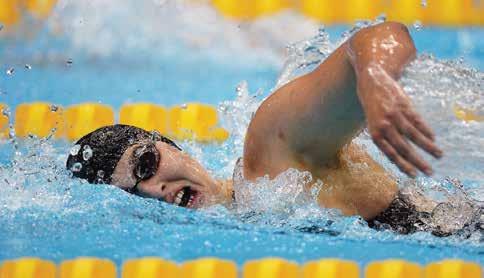
sU zanne sCOTT
s ele CT ed f O r firs T
Team U sa f ell OW s H ip
W i TH e l pO mar
fOU nda T i O n
Two-time Paralympian, Suzanne Scott, joined El Pomar Foundation in July, 2014 as the inaugural member of the Team USA Fellowship. El Pomar Foundation supports Colorado nonprofit organizations involved in health, human services, education, arts and humanities, and civic and community initiative.
Suzanne’s selection into this newly established partnership between El Pomar Foundation and the United States Olympic Committee provides her with the opportunity to participate in this highly selective, one-year leadership training program. The goal of the partnership is to develop today’s elite athletes into tomorrow’s leaders. It is designed to develop leadership and professional skills in a dynamic, active, hands-on program that will serve them in business, government, academia and the nonprofit sector.
Born in the small town of Cape Girardeau, Missouri, Suzanne moved to Colorado Springs in 2007, at the age of 15 to train at the Olympic Training Center. Suzanne was a member of the US National Paralympic Swim Team from 2006 to 2014. She earned a bronze medal in the 400 meter freestyle at the Beijing 2008 Paralympic Games. She was nominated for an ESPY Award for the Best Female Athlete with a Disability in 2008. In the London 2012 Paralympic Games, Suzanne won a bronze medal in the 400 meter freestyle, a bronze medal in the 4 X 100 meter medley relay and a silver medal in the women’s 4 x 100 meter freestyle relay.
At the Foundation, Suzanne works on the funder’s research team, the Empty Stocking Fund and in the Grants Office. In addition to the El Pomar Fellowship, Suzanne is pursuing her Associate of Arts degree at Pikes Peak Community College. Upon completing the Fellowship, Suzanne plans to earn her Bachelor’s degree in psychology and pursue a career in the nonprofit sector.
Your donation will help us provide, but not limited to, needed medical assistance, prescription medication, replacement of stolen articles, or automobile repair for Olympians who have fallen victim to accident, illness, or injury.
How is it spent?
Once approved by our board of Olympians, the grants will allow individuals who have served this country with distinction, to return to a life of active and productive engagement.
budget
The OORF is staffed entirely by U.S. Olympians who volunteer their time and energy. 100% of all donations go directly to providing assistance to America’s Olympic heroes, and the U.S. Olympic Committee has been matching each gift, dollar for dollar.
Past recipients
Past recipients have told us that the OORF grant has made it possible to recover more quickly from surgeries, lost jobs and catastrophic accidents. These gifts have reminded our recipients that their service on the U.S. Olympic team has not been forgotten, and in many cases has also reconnected them to the Olympic Family. DONATIONS
Spirit of Sochi celebrated the Olympic and Paralympic spirit while educating the public about Lakeshore Foundation’s programs and services.
THE OLYMPIAN NEWSLETTER 9 aTH le T e Career & e d UC a T i O n ( a C e ) p r O gram OOR F YOU CAN NOW D ONAte O N li N e t O OORF At HTTP://WWW.OORf.ORg/dONATE
your Donation
DEDUCTIBLE
ARE TAX
Olympic Champions
H as a ni C e ring TO i T d O esn’
By Amy Rosewater
There were many days following the Sochi 2014 Olympic Winter Games which Charlie White had no idea what city he was in or the day of the week.
His head was spinning faster than any twizzle he and ice dancing partner Meryl Davis had ever performed on the ice.
“Unless it was Monday, I really didn’t know where I was,” White said with a laugh.
dancing, Davis and White were literally thrown into a whirlwind. Not only were they doing a siege of media events, as they appeared with everyone from Katie Couric to Stephen Colbert, but they were also touring around the nation to perform in 20 “Stars on Ice” shows and then competing on “Dancing with the Stars” — a show that Davis wound up winning with partner Maks Chmerkovskiy.
“Surreal is the best way to explain it; there were definitely points where I didn’t know if I was going to survive,”

Why Monday you ask?
Mondays were his only real frame of reference since that was the day he knew he had to be in Los Angeles for the TV reality hit, “Dancing with the Stars.” The show aired Monday nights, and only then did White have any clue of his whereabouts.
After becoming the first Americans to win the Olympic gold medal in ice
White said during a rare moment of down time after his time on “Dancing with the Stars” came to an end and before he could enjoy a much-needed Hawaiian vacation. Even during his tropical respite, White continued to make news as he proposed to his longtime girlfriend and 2006 Olympic ice dancing silver medalist Tanith Belbin.
“We just never had a break,” White said. “It has just been go, go, go.”
Davis, too, took a Hawaiian vacation (albeit apart from White), but their schedules picked up speed once again. The two were scheduled to tour in Japan in July, perform in Sun Valley, Idaho, in August and then were recently announced as grand marshals of the Thanksgiving Parade in their hometown of Detroit. They also are scheduled to perform in a handful of made-for-TV skating specials this Fall.
Davis and White announced that they will not compete this season, marking a strange absence in U.S. figure skating since they have spent 17 seasons together, but that doesn’t really mean they will have much of a break in their lives.
As competitors, Davis and White won two Olympic medals (including a silver medal at the Vancouver 2010 Olympic Winter Games), two world titles and six national championships. The University of Michigan students, who each have about a year of classes remaining before graduating, plan to take online courses as well.
Davis and White are reaping the benefits of decades of hard work not only from themselves, but from generations of ice dancers before them. Although the U.S. earned the bronze medal in ice dancing’s Olympic debut in 1976 (Colleen O’Connor and Jim Millns), Americans were shut out of the ice dancing medal podium for decades afterward. It wasn’t until 2006 –30 years after O’Connor and Millns – that an American team medaled again when Tanith Belbin and Ben Agosto earned a silver medal in Torino.
Four years later in Vancouver, Davis and White matched that effort with a silver
10 THE OLYMPIAN NEWSLETTER
Meryl Davis and Charlie White of the United States compete in the Figure Skating Ice Dance Free Dance on Day 10 of the Sochi 2014 Winter Olympics at Iceberg Skating Palace on February 17, 2014 in Sochi, Russia.
T i T !
medal of their own. But they wanted to make history, and thus went on to become the first American team to win a world title before seeking the ultimate prize: an Olympic gold medal. They won in Sochi in dramatic fashion by beating their training mates and biggest rivals, the 2010 champion team of Tessa Virtue and Scott Moir of Canada.
Davis and White had wanted an Olympic gold medal and all the perks that came along with it, but had no idea what to expect in the Sochi aftermath. Davis said that as she was training for Sochi and juggling the multiple media events that went along with the Olympic Winter Games, she thought her life could never be any busier. However, she found out just how far she could push herself after winning the gold medal.
“When you are training you still think a lot about recovery and sleep time,” Davis said. “After the Olympic Games, it was all about going and we never really got on a schedule.”
Not that Davis and White hadn’t done their research, as they had been on the “Stars on Ice” tour following the 2010 Winter Games and witnessed a beleaguered Evan Lysacek go through the jet setting that came with combining “Dancing with the Stars” and the skating tour. On paper, Davis said, it seemed like a pretty doable plan.
Now that they have gone through “the double” themselves, they know firsthand how exhausting it really is. Davis said that there was one tour stop (of course, she can’t recall exactly what city they were in) when she collapsed on the locker room floor and slept. As it turns out, she said with a laugh, the same thing happened to White the same day in the men’s locker room. Lysacek’s run now looks all the more impressive.
“I tell you now,” Davis said, “my hat’s off to him!”
Being on the show and on tour resulted in Davis and White living in somewhat of a bubble. Davis likened their lives during that period of time to being a kid in school.
“It’s hard to grasp that life goes on during your school day,” Davis said.

Davis and White truly felt that when they connected with Olympic teammates and training mates Maia Shibutani and Alex Shibutani, who came to see the “Stars on Ice” show in Detroit. The Shibutanis were chatting about their upcoming programs, which traditionally are choreographed in the summer, and Davis and White realized they were not working on new programs of their own.
It’s not that Davis and White aren’t enjoying their lives now. They love performing in front of their fans, whether it be on the dance floor or on the ice, and they certainly like the ring when they are announced as Olympic champions.
“It was hard to grasp when we were first introduced as Olympic champions,” Davis said. “We had been working for it for so long and to finally listen to our names being announced as the champions in front of our fans was amazing.”
Fans continually ask Davis and White what experience has been more exciting – winning a gold medal in Sochi or dancing in front of millions of TV viewers. It’s hard for them to answer, especially since the experiences are so intertwined.
“That post-Olympic high has really continued on throughout the course of
“Dancing with the Stars,” and beyond,” Davis said. “It doesn’t feel like the Olympic Games were however many months ago.”
The two are excited about being able to continue to perform together and get involved in different projects. However, skating always will be a part of their lives. White said he has some interest in coaching, and the two have a vested interest in growing the sport of ice dancing in the U.S.
“It’s incredibly important to us to keep ice dancing strong,” Davis said. “Charlie and I have had some amazing role models and we know first-hand what that means. Being a role model is something that we don’t take lightly.”
And they will forever be linked together. White might be engaged to Tanith Belbin and Davis’ off-screen friendship with ‘Dancing’ partner Maks Chmerkovskiy made plenty of headlines in magazines, but Davis and White always will be a pair.
“Our lives have really changed,” Davis said. “But this journey together is still continuing.”
THE OLYMPIAN NEWSLETTER 11
Winners of “Dancing With The Stars” Season 18 Meryl Davis and Maksim Chmerkovskiy
Echo summit
m em O ries r elived
By Elliott Denman (track & field, 1956)
Forty-six years have flown by, but to the U.S. track and field Olympians who punched their tickets to the Mexico City 1968 Olympic Games at the iconic Echo Summit site, some 95 miles west of Sacramento, the memories are as strong and emotion-filled as ever.
To backtrack, the siting and scheduling of those Games of the XIX Olympiad posed very special problems. Booked for Oct. 12-27 (only the Melbourne 1956 Olympic Games were staged later in the calendar year) in the 7,546-feet, some mile-and-a-half-high Mexican capital, the 1968 Games gave USOC organizers an array of headaches. How to deal with the altitude? How to deal with the lateyear dates? How to deal with Mexico’s well-known health and water situations?
Here’s where Echo Summit entered the Olympic picture: a site to replicate Mexico City’s altitude. Echo Summit was chosen to host the men’s U.S. Track and

Field Olympic Trials, while the semifinal trials, a qualifying meet, were held June 29-30 in Los Angeles.
Having no track, amenities or history in the sport were not considered a problem by Walt Little, recreation director for Echo Summit. He convinced Bill Bowerman, University of Oregon track and field coach and director of the U.S. Olympic High Altitude Training Program, that Echo Summit would provide all of the answers. And it did.
Having no track, amenities or history in the sport were not considered a problem
A 400-meter track – colored a distinctive pink – was put down near Eldorado National Forest off of Route 50, an area previously best known for ice, snow and trees. Instead of leveling the entire
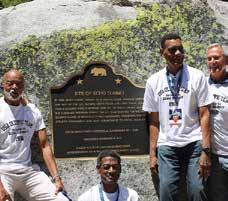
area, hundreds of pine trees remained standing on the infield. To finance this project, Little literally mortgaged his family’s home and real estate holdings. And what a project it became; Walt Little Jr., son of the site’s creator, still calls the Echo Summit venue “the most beautiful track and field arena the world has ever seen.” Certainly, it was one of the fastest
tracks the world has ever seen, proven by the results of those U.S. Olympic Trials, held Sept. 6-16.
Winning performances included sensational marks, such as Jim Hines running the 100 in 10.11, John Carlos clocking 19.92 in the 200, and Lee Evans with a time of 44.06 in the 400. Carlos’ time of 19.92 bested the world record, but never went into the books because he ran in experimental (and later deemed illegal) “brush-spiked” shoes. Evans also broke the previous world record in the 400, along with second-place finisher Larry James with a time of 44.19

(Evans would lower that record to 43.86 in Mexico City, edging James by 11 hundredths of a second). Bob Beamon, destined to shatter the long jump world record with his historic 8.90-meter jump at Mexico City, used his win at Echo Summit as a warmup. Geoff Vanderstock crossed the finish line in 48.93 for the 400 hurdles world record.
Despite its formidable obstacles, that star-filled U.S. men’s track and field squad would go on to win 12 gold medals at the 1968 Games – a total which was
12 THE OLYMPIAN NEWSLETTER
topped, in the modern era of the Games, only by the 1956 Melbourne teams’ 15 golds. And no less than 20 of those 1968 Olympians were eventually voted into the National Track and Field Hall of Fame. So, with all of those memories of the training period and Olympic trials at Echo Summit, followed by their deeds in Mexico City, a contingent of 1968 Olympians made a sentimental journey back to the scene of all those Olympic trials achievements.
Among those on hand for the dedication of a plaque designating Echo Summit as a California Historical Landmark on the morning of June 27 were
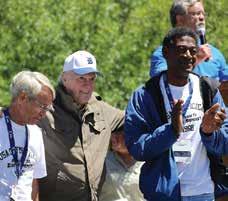
sprinters Tommie Smith, John Carlos and Mel Pender, 10,000-meter runner Tracy Smith, 400-meter hurdler Geoff Vanderstock, 50K race walker Larry Young, high jumpers Ed Caruthers and Reynaldo Brown, triple jumper Norman Tate, hammer thrower Ed Burke and decathlete Bill Toomey. The plaque reminded the crowd, “The U.S. team selected for the 1968 Olympic Games in Mexico City was celebrated worldwide for its athletic dominance and deep commitment to racial equality.” Carlos, (Tracy) Smith, Vanderstock, Young, Caruthers, Burke and Toomey were winners at the 1968 U.S. Olympic Trials. (Tommie) Smith and Toomey would collect gold medals in Mexico City. Of course, Tommie Smith and Carlos (who ran 1-3 in the Olympic 200 final) earned
headlines that far transcended their medal achievements.
On the victory stand – remember that these were turbulent times in their nation’s grudging advances in the field of civil rights – Smith and Carlos each wore civil rights badges, bowed their heads as the “Star Spangled Banner” was played, and raised one black-gloved hand in Black Power salutes. After an initial reluctance to act on an IOC request, the
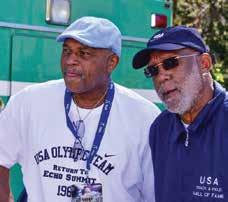
U.S. Olympic Committee relented and barred the pair from further competition in the 1968 Games, including the 4x100. They were destined to endure the barbs of many elements of the American media and frequent adverse reaction in their everyday lives.
“Mr. Smith and I, in particular, we were vilified,” said Carlos.
“We felt pressure the whole time,” said Tommie Smith.
But times would change, as their nation would make major progress in the civil rights battle, and feelings on all sides would mellow. To many now, the Smith-Carlos gesture is considered an act of patriotism. The moment is commemorated in a statue of the pair, which is located on the San Jose State University campus.
The passing years only added to the
poignancy of the Echo Summit reunion. “It was an amazing event,” said race walker Larry Young, whose two 50K bronze medals (1968 and 1972) represented the highest-ever U.S. finishes in the 31.1-mile test that is the longest on the Olympic program. “A lot of us hadn’t seen each other in a long time,” said Young, now a noted sculptor. “I walked a lot of laps around that track. And we had a lot to remember.”
“I haven’t been back here in 46 years,” said Vanderstock. “Probably half of these guys I haven’t seen in 46 years, too. “I’m just kind of flabbergasted. I haven’t signed an autograph in 46 years.”
A driving force behind the reunion was Bob Burns, a former Sacramento Bee sports writer. As Burns put it, “few teams mirrored the social climate of their times as much as the 1968 Olympic track team.”
The training and Olympic trials period lasted only 100 days. Immediately after the final of the trials, the track was torn down and reassembled at South Lake Tahoe Intermediate School. It endured there until 2007, but chunks of it remained and were reformulated into very-special souvenirs that the ‘68 team members were able to take home with them. The reunion and plaque dedication were staged in coordination with Sacramento’s hosting of the U.S. Outdoor Track and Field Championships, held at Sacramento State University’s Hornet Stadium.
And so those ‘68 Olympians were honored all over again at the biggest meet on the U.S. home calendar. As they reveled in the spotlight one more time, more than one of them would say, “it seems like all we went through was just yesterday.”
THE OLYMPIAN NEWSLETTER 13
Throughout the month of June, over 500,000 Americans celebrated Olympic Day while participating in 1,055 celebrations in 813 cities. More than 892 Olympians, Paralympians, coaches and hopefuls helped to spread the Olympic spirit across the United States. While attending Olympic Day events, athletes shared the Olympic Ideals of fair play, perseverance, respect and sportsmanship.
In Dallas, the Southwest Chapter of the U.S. Olympians and Paralympian s Association had an impressive 28 Olympians attend an event at the Beckley-Saner Recreation Center. With
3,000 summer campers in attendance, it was a day filled with fun, laughter and a commitment to the Olympic Movement. Olympians in attendance included Sam Walker (weightlifting, 1976), Janine Bowman (shooting, 2000), Jim Montgomery (swimming, 1976), Michelle Carter (track and field, 1984), Carrie Barton (synchronized swimming, 2000) and Paralympian Derek Arneaud ( soccer, 2004).
Across the country, in Pittsburgh, Olympic gymnasts Gabby Douglas and Ron Galimore led the charge in breaking a world record for the most simultaneous cartwheels. Gabby had over 700


gymnasts join her on the Roberto Clemente Bridge, where they succeeded in breaking the record by completing 732 simultaneous cartwheels.
For the second year in a row, Olympic speed skater Nathaniel Mills participated in Chantilly, Virginia’s Skate of the Union. This year, Nathaniel and a group of skaters enjoyed a night skate through the District of Columbia’s Washington Monument just as the sun was setting. It was the perfect way to take in the sites, celebrate Olympic Day and commit to a healthy lifestyle.
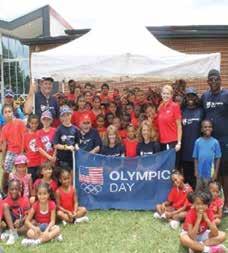
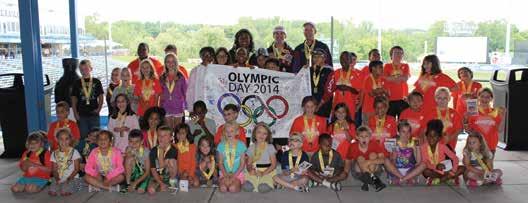
14 THE OLYMPIAN NEWSLETTER
Covington,Ga. Cornerstone Track and Athletic Association. Bob Pickens (wrestling, 1964)
Dallas, Texas. South West Chapter - U.S. Olympians and Paralympians Association
Manhattan, Kan., Boys and Girls Club of Manhattan, Ed Broxterman (track & field, 1996)
Grand Rapids, Mich. YMCA Grand Rapids, Gary Morgan (track & field, 1988), Nick Baumgartner (snowboarding, 2010, 2014) and Judi Brown Clarke (track & field, 1984)
a l U mni in HO n O r
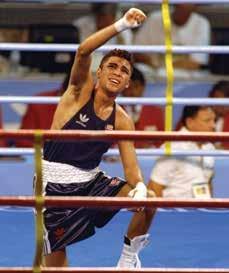
Oscar De La Hoya Inducted into Boxing Hall of Fame (Boxing, 1992 )
Capping a career that included 10 titles in six weight divisions, an Olympic gold medal and 10 world titles, the ‘Golden Boy’ has found a permanent home.
Oscar De La Hoya was inducted into the International Boxing Hall of Fame.
“Today marks an incredible personal achievement,” said De La Hoya, who had an amateur record of 223-5 with 153 knockouts. “But it is only the latest milestone that never would have been possible without my family, my friends and, most of all, my fans.”
The Hall of Fame’s 25th class also included two of De La Hoya’s contemporaries in the modern era –Puerto Rican star Felix “Tito” Trinidad and Joe Calzaghe of Wales. Inductees were selected by the Boxing Writers Association and a panel of international boxing historians.
De La Hoya won the lightweight gold medal at the Barcelona 1992 Summer Olympics. He turned pro later that year
and captured his first world title, the WBO super-featherweight crown, in only his 12th bout.
De La Hoya also won titles as a lightweight, light welterweight, welterweight, light middleweight and middleweight. His 2007 bout with Floyd Mayweather Jr., was one of the richest in boxing history, attracting nearly 2.5 million pay-per-view fans. He retired after a 2008 loss to Manny Pacquiao, boasting a professional record of 39-6 with 30 knockouts, and then established Golden Boy Promotions in 2002.
De La Hoya touched on numerous topics during his speech, including the future of the sport.
“We must put aside the egos that have damaged our brand and sullied our reputation,” he said. “We, the promoters, must stop carrying petty grudges that serve no purpose but to divide our sport. And most important, we must give the fans the fights that they want.”

Detroit Boat Club Crew honors Eugene “Genks” O’Brien
The Detroit Boat Club Crew honored Eugene “Genks” O’Brien, who was a member of the 1940 Olympic Four
Rowing Team during their 175th anniversary banquet. Other members of the crew include Robert DeClercq, Ralph Vigliotti, William McNaughton and Coach Judson Ross.
Five United States Olympians Honored at Hall of Fame Induction Ceremony
Five U.S. Olympians were among the class of 2014 inductees to the Hall of Fame, held June 27 at the Columbus Convention Center in Columbus, Ohio, in conjunction with the USA Fencing
National Championships.
The class of 2014 inductees includes: Keeth Smart (Brooklyn, New York), 2008 Olympic silver medalist
Erinn Smart (Brooklyn, New York), 2008 Olympic silver medalist
Ivan Lee (Brooklyn, New York), 2004 Olympian
James Melcher (New York City, New York), 1972 Olympian
Ed Vebell (Westport, Connecticut), 1952 Olympian
Alec Hern (New York City, New York), coach of 1960 Olympic medalist Albie Axelrod
Vladimir Nazlymov (Columbus, Ohio), three-time Olympic Champion and coach at Ohio State University
Hippolyte Nicholas (New York City, New York), coach of the Fencers Club
Richard Oles (Pasadena, Maryland), coach at Johns Hopkins University
THE OLYMPIAN NEWSLETTER 15

a l U mni in mem O riam

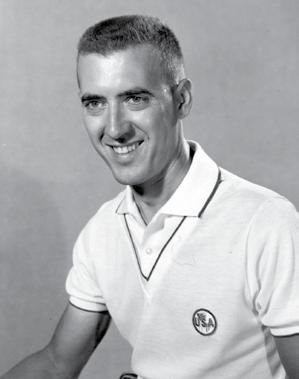
Joseph Harry “Joe” Becker (Cycling, 1956)
Joe Becker died on June 11, 2014. He was 82 years old.
He was a pilot in the U.S. Air Force and retired as captain. He represented the U.S. at the Melbourne 1956 Olympic Games in the 117-mile cycling road race, and was the only American to cross the finish line – he was also a member of the 1959 Pan American Cycling Team.
Joe was former president and lifetime member of the St. Louis Cycling Club. He loved family, playing tennis, cycling, nature and his many pets.
He is survived by his wife, Mary Ann; six children, Janie, Lisa (Brice), Karl, Mary Margaret (Bill) Paul (Cyndi), Amy (Steve); 11 grandchildren; and two greatgrandchildren.
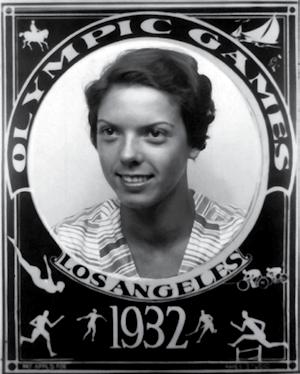
Helen Eileen Johns Carroll (Swimming, 1932)
Thomas Helen Eileen Johns Carroll died on July 23, 2014. She was 99 years old.
While in high school, Helen began to compete as a freestyle swimmer, eventually to become both a national and New England swimming champion, as well as record holder. In 1932, Helen won a place on the U.S. Olympic Team as a member of the women’s swimming and diving squad. As one of the four fastest swimmers, Helen was selected for the U.S. Women’s Freestyle Relay Team, which competed against teams from Canada, Holland, Japan and Great Britain. The U.S. won the gold medal while setting new world and Olympic records.
In 1936, Helen graduated from Brown University in Providence, Rhode Island, with a Bachelor of Arts degree in psychology and economics. After their marriage, Helen and her husband lived in the small town of Swansea Village, Massachusetts. The textile industry brought the Carrolls to Sumter, South Carolina, from Massachusetts in 1957, and Helen became a teacher for Sumter School District 17. During this time period, Helen helped start a program of instruction in swimming for elementary school students. In 1967, she received a fellowship for study at the University of South Carolina. She graduated with a Master’s Degree in the class of 1969, and soon after in 1970 she was selected to participate in the Robert A. Taft Seminar in Government at Clemson University.
She retired from teaching in 1980 to become active as a volunteer, travel, enjoy hobbies and family activities. Throughout her teaching and retirement years, Helen often agreed to speak about her Olympic experience and the Olympic Movement.
When Atlanta hosted the 1996 Summer Olympic Games, Helen helped carry the torch with the Olympic flame in Columbia, South Carolina on its way to Atlanta. At the time of her death, she was the secondoldest living U.S. Olympic champion and the fourth-oldest living gold medalist in the world.
Helen was a vibrant individual who enjoyed people, good conversation, reading and who was a captivating story teller. Throughout her life, she had many dear friends and colleagues, was devoted to her family and a “rock star” to her grandchildren.
Helen was a member of St. Anne Catholic Church. Over the years, she participated in the League of Women Voters, Alpha Delta Kappa, Daughters of the American Revolution, Society of Mayflower Descendants, Sumter YMCA, The Shepherd’s Center, Sumter Gallery of Art, Sumter Little Theatre, U.S. Olympians, Sumter Newcomers and Green Thumb Club. She was a charter member of the Sumter Friends of the Library.
She was elected to the Brown University Hall of Fame for Sports in 1981, The Sumter Sports Hall of Fame and the Rhode Island Sports Hall of Fame. In 2013, she received the DAR Award for Women in American History.
THE OLYMPIAN NEWSLETTER 17

a l U mni in mem O riam (continued)

Devere Christensen (Water polo, 1948)
Devere Christensen died on December 12, 2013. He was 95 years old.
He was a former U.S. water polo player who competed at the London 1948 Summer Olympics. Born in Hamilton, Iowa, and competing out of the Los Angeles Athletic Club, he was a member of the U.S. national team that was eliminated in the second round of that year’s water polo tournament.
Christensen attended the University of California, Los Angeles, and was a member of the school’s water polo team from 1939 through 1941, during which he was captain of the squad in 1940 and 1941. Prior to college, he attended Fullerton Union High School and was a California Interscholastic Federation swimming champion in the 220-yard event. He was also a member of the LAAC squad that won the 1947 National Amateur Athletic Union Water Polo Championship.
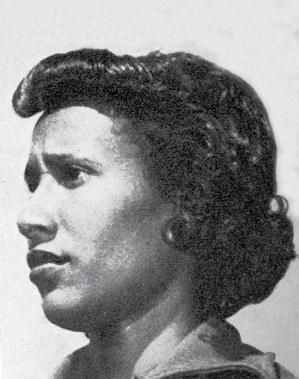
Alice Coachman Davis (Track and Field, 1948)
Alice Coachman Davis died on July 14, 2014. She was 90 years old.
Alice Coachman Davis was the first black woman to win an Olympic gold medal. She won gold in the high jump at the London 1948 Olympic Games with an American and Olympic record of 1.68 meters, according to USA Track and Field. She was inducted into the USA Track and Field Hall of Fame in 1975, and the U.S. Olympic Hall of Fame in 2004.
“Going into the U.S. Hall of Fame is as good as it gets,” she told The Associated Press in a 2004 interview. “It’s like Cooperstown, Springfield and Canton,” she said, referring to the sites of other prominent hall of fames. She was the only American woman to win a gold medal at the 1948 Games and was honored with a 175-mile motorcade in Georgia when she returned from London.
Recollecting her career in the 2004 interview, Davis speculated that she could have won even more Olympic medals, but the Olympics weren’t held in 1940 or 1944 because of World War II.
She retired at age of 25 after winning the gold medal in London. “I know I would have won in 1944, at least,” said Davis. “I was starting to peak then. It really feels good when Old Glory is raised and the national anthem is played.”
She attended Tuskegee University, and
also played basketball for the team that won three straight conference basketball titles. She won 25 national track and field championships – including 10 consecutive high jump titles from 1939 to 1948. She earned a teaching degree from Albany State College, where she transferred after the Olympic Games. Alice taught elementary and high school students while continuing to encourage young men and women to pursue athletics. She founded the Alice Coachman Track and Field Foundation, which provides financial assistance to young Olympic hopefuls, as well as Olympic veterans.
Growing up in the Deep South during the era of legal segregation, Davis had to overcome multiple challenges. She was prohibited from using public sports facilities because of her race, so she used whatever equipment she could cobble together to practice her jumping. She won her first national high jump title at age 16.
“My dad did not want me to travel to Tuskegee and then up north to the Nationals,” Davis told the AP. “He felt it was too dangerous. Life was very different for African-Americans at that time, but I came back and showed him my medal and talked about all the things I saw. He and my mom were very proud of me.”
Davis worked as a school teacher and track coach after retiring. An elementary school in her hometown is named in her honor and opened in August, 1999. Davis is honored annually with the Alice Coachman Track Invitational held at Albany State.
18 THE OLYMPIAN NEWSLETTER

Sam Hall (Diving, 1960)
Sam Hall died on August 11, 2014. He was 77 years old.
Sam competed at the Rome 1960 Olympic Games, in which he won a silver medal in the three-meter springboard.
During his college years and as a member of the diving team at Ohio State University, he was the NCAA champion in one-meter diving in 1960, and in three-meter diving in 1959 and 1960.

Wallace

Robert Wallace Jones died on July 27, 2014. He was 88 years old.
Wallace was the son of Faye and Hugh Jones. He was preceded in death by his
four siblings Dukie, Hugh, Evelyn and Jackie. Wallace married his beloved Edna Ball in Middlesboro, Kentucky, on August 9, 1947. They were married for 56 years before her passing in 2003. His family was the most important thing in his life.
Even though Wah Wah became somewhat of a star after all of his athletic success at the University of Kentucky, he still found time to attend most of the sporting activities of his children and grandchildren. He also loved all of the family dogs and, especially Abbie, a little dog who was his constant companion after the passing of his wife.
He was a member of the Lexington Country Club where he could be found often playing golf. He wanted to play golf while at UK but after playing basketball, football, baseball and running track, he couldn’t manage to find time. His accomplishments include being a member of the original Fabulous Five, member of the 1948 and 1949 NCAA Basketball Champion team, gold medalist in basketball at the London 1948 Olympic Games, earning All-American honors in both football and basketball, as well as All-SEC honors in baseball and earning varsity letters in track and field. Wah Wah has had his No. 27 jersey retired in both basketball and football, and is the only player elected as an SEC “Living Legend” honoree in both basketball and football. Wah Wah is a member of the inaugural Kentucky High School Basketball Hall of Fame.
He also served as the President of Blue Grass Tours, a charter bus and tour company. He was a member of Immanuel Baptist Church. He was a huge supporter of Cardinal Hill and of the Bash, the Goodwill Games, a member of the Lion’s Club, and many other activities. He was the first Republican Sherriff elected in Fayette County serving from 1954-1958.
He is survived by his children, Wallace “Wah” Jones, Jr., of Lexington, Kentucky, Vicki Jones of Lexington, Kentucky, and Ira Dawson (Bruce), of Louisville, Kentucky; his grandchildren, Brian Mains (Crystal), of Louisville, Kentucky, Shawna Landers of Florida, Cara Canada (Brandon), of Louisville, Kentucky,
Ashley Dawson of Louisville, Kentucky, and Corey Jones (Ashley), of Lexington, Kentucky; his great-grandchildren, Taylor Mueller and Amelia Mains, Addilyn and Lucas Landers, Ali and Reagan Canada, Carson Jones, and Judy Jones, mother of grandson Corey.
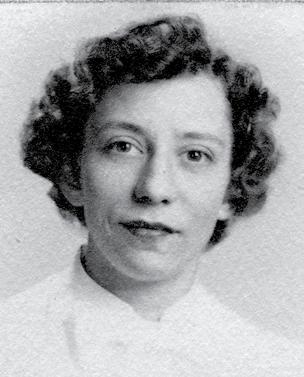
Clara Schroth Lomady (Gymnastics, 1948, 1952)
Clara Schroth Lomady died on June 7, 2014. She was 93 years old.
The daughter of the late William and Elizabeth Schroth and wife of the late Wendell ”Fuzz” Lomady. Clara graduated from Frankford High School in Philadelphia. She is survived by her children, Susan Lomady (Joe) Martin of Carlisle, Pennsylvania, Nancy Lomady (Ed) Schale of Shippensburg, Pennsylvania, Frederick (Maureen) Lomady of Willow Grove, Pennsylvania and Judith Lomady (George) Schrieber of Carlisle, Pennsylvania, as well as 16 grandchildren and four great-grandchildren.
Clara is an Olympic bronze medalist, participating in both the London 1948 and Helsinki 1952 Olympic Games on the U.S. women’s gymnastics team. She was team captain on both, and her specialty was the balance beam. Clara was inducted into the USA Gymnastics Hall of Fame in 1974, and holds the record for the most AAU titles of any female athlete.
Clara was a Girl Scout leader and enjoyed camping, bird feeding and watching. She worked as a secretary in the Abington
a l U mni in mem O riam (continued)
“Wah Wah” Jones (Basketball, 1948)
THE OLYMPIAN NEWSLETTER 19
a l U mni in mem O riam (continued)

School District. Spending summers on Long Beach Island, New Jersey, was a family favorite. A long standing member of the Reformed Church of Willow Grove, Clara sang in the church choir with her late husband Wendell.
The number one fan of her children and grandchildren, Clara will live on in their hearts and lives.
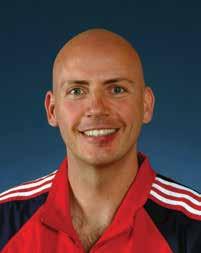
Jon McCullough (Paralympic Soccer, 1996, 2004)
Thomas Jon McCullough died on August 15, 2014. He was 48 years old.
Jon graduated from Rappahannock County High School in Washington, Virginia, in 1985, and served in the U.S. Coast Guard. A disabled veteran, Jon sustained a traumatic brain injury with permanent neck and shoulder damage in an accident while his Coast Guard cutter was on drug patrol in heavy seas. Following a medical discharge, he attended the American University in Washington, District of Columbia, graduating with a degree in environmental health.
His advocacy of sports for individuals with disabilities began while he was at AU with his volunteer service as competition coordinator for the men’s standing volleyball team. He went on to try out for the Paralympic National Men’s Soccer Team and was a starter for Team USA for 12 years, playing in the Paralympic Games in Atlanta and Athens and carrying the Paralympic torch in the ceremonies to
begin the London 2012 Paralympic Games. He played in three World Championships and three Para-Pan American Games, was named to the World All-Star team in 1988, in which he earned the tournament’s sportsmanship award. McCullough was also chosen by his peers to be athlete coordinator for the Salt Lake City 2002 Paralympic Games, Innsbruck 2005 World University Games, Torino 2006 Winter Olympic Games and Beijing 2008 Summer Olympic Games. McCullough’s passion for soccer also led him to serve in leadership and volunteer roles with the Olympic and Paralympic Games. He was a member and chair of the U.S. Olympic Committee’s Athletes Advisory Council, Chairman of U.S. Soccer’s Athletes Council and member of U.S. Soccer’s Board of Directors. McCullough also served on the International Paralympic Committee’s Athlete Council and the U.S. Olympic Committee’s Paralympic Advisory Committee.
At the 2010 FIFA World Cup in South Africa, McCullough was a keynote speaker for the Man-Up Summit, a week-long gathering of 150 international delegates seeking to develop domestic initiatives to end violence against women and girls, using sport and music as tools. Also in South Africa, McCullough was a facilitator for FIFA’s youth initiative, Football for Hope. For the Vietnam Veterans of America Foundation, he developed a conflict resolution program centered on soccer first implemented in the former Yugoslavia. With children from different sides of the conflict playing together on the same teams, the games were broadcast on national television and featured in the World Bank film, Transcending Sport. In 2013, McCullough became executive director of BlazeSports America, based in Decatur, Georgia. A non-profit heritage organization from the Atlanta 1996 Paralympic Games, Blaze provides children and adults with physical disabilities the opportunity to improve and enrich their lives through participation in athletics and competitive sports.
McCullough is survived by his mother, Daphne I. Hutchinson, of Washington, Virginia; two brothers, Joseph E. McCullough of Anchorage, Alaska, and James P. McCullough of Nassau,
Bahamas, and one sister, Katherine J. Hutchinson of Washington, Virginia.
The family suggests that expressions of sympathy be made as donations to BlazeSports America.
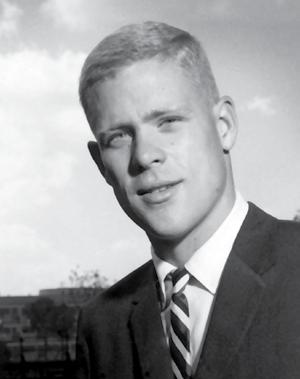
Bill Mulliken (Swimming, 1960, )
Bill Mulliken died on July 17, 2014. He was 74 years old.
Bill will forever be remembered as one of the greatest athletes to wear red and white. One of the most talented and decorated athletes in Miami University swimming history, Mulliken became the first swimmer inducted into the Miami Hall of Fame in 1971.
In 1959, Mulliken won an NCAA and Olympic championship, both of which were firsts for a Miami athlete. The following year he won a gold medal in the 200-meter breaststroke at the Rome 1960 Olympic Games.
A nine-time Mid-American Conference champion, Mulliken set 15 Miami, MAC, American, NCAA and Olympic records during his tenure. Best known for setting the Miami, American, NCAA and Olympic record in the 200 breaststroke, Mulliken became only the third All-American swimmer from Miami.
Mulliken completed his degree at Miami before earning a law degree from Harvard Law School.
20 THE OLYMPIAN NEWSLETTER
a l U mni in mem O riam (continued)




George Bissland Moore died on July 4, 2014. He was 95 years old.
Moore was an American modern pentathlete who competed in the London 1948 Summer Olympics, in which he won a silver medal.
He was a track and field athlete for the United States Military Academy at West Point prior to becoming involved in modern pentathlon. He served in the U.S. Army during World War II and was injured, earning a Purple Heart, two Bronze Star Medals and the Legion of Merit. After the war, he taught at West Point before retiring in 1965 as a colonel to pursue a career in computer management and educational administration.
Melvin Patton died May 9, 2014. He was 89 years old.
Melvin won two gold medals at the London 1948 Olympic Games. “Pell Mell”, as he was nicknamed in the late 1940s, made his mark in track and field as a student at the University of Southern California. During his collegiate years, Patton was a member of the Delta-Eta Chapter of the Kappa Sigma fraternity. He attended University High School in Los Angeles.
Patton won the NCAA 100-yard dash in 1947, and in 1948 and 1949 completed both the 100 and 220 sprint double in that same meet. In 1947, he tied the 100 world record of 9.4, which he then lowered to 9.3 the following year. In 1949, he set a 220 world record on a straightaway of 20.2, breaking the record held by Jesse Owens.
In the U.S. Olympic Trials, he suffered a rare loss to Barney Ewell in the 100-meter final, then in the 1948 Games placed only fifth in the 100. He atoned for that disappointment by taking gold medals in the 200 and the 4x100.
After retiring from competition, Patton was a track coach before entering the electronics industry.
William “Bill” Wall died on August 4, 2014. He was 83 years old.
Wall graduated in 1948 from Marysville High School in Ohio, and then received Bachelor of Science and Master of Arts degrees from Ohio State University, as well as a Doctorate of Public Service from MacMurray College (Honorary). Wall dedicated much of his life to the sport of basketball at the collegiate, Olympic and professional levels, and touched many lives through players, coaches, officials and administrators in both the United States and through his involvement with the International Federation of Basketball.
Wall began his coaching career in 1953 at the Ohio high school level with Summitt Station and Grandview High Schools in Columbus, Ohio. In 1956, he became head basketball coach at Ripon College in Wisconsin. In 1957, Wall became the head basketball, soccer and baseball coach and later the Athletic Director at MacMurray College in Jacksonville, Illinois.
In 1975, Wall was named the Executive Director of the Amateur Basketball Association of the United States of America, which is currently known as USA Basketball. He served in the organization for seventeen years overseeing the 1984 double gold-medal performance by men’s and womens basketball, and the 1992
George Bissland Moore (Modern Pentathlon, 1948)
Melvin Patton (Track and Field, 1948)
William “Bill” Wall (Former USA Basketball Executive Director)
THE OLYMPIAN NEWSLETTER 21
a l U mni in mem O riam (continued)

Games known for the “Dream Team”. After his career with USA Basketball, Wall continued to work and consult at the international level with basketball coaches and teams while representing the U.S. One of his greatest honors was serving on the Board of Directors for both the Mens and Womens Basketball Hall of Fame.
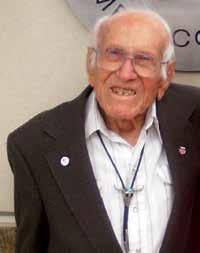
Louis Zamperini (Track and Field, 1936)
Lou Zamperini died on July 2, 2014. He was 97 years old.
Zamperini was a World War II prisoner of war survivor as well an Olympic distance runner. He is the subject of Lauren Hillenbrand’s book, “Unbroken,” which was adapted into a film by the Coen brothers, and directed by Angelina Jolie.
“Having overcome insurmountable odds at every turn in his life, Olympic runner and World War II hero Louis Zamperini has never broken down from a challenge,” Zamperini’s family said in a statement.
“He recently faced the greatest challenge of his life with a life-threatening case of pneumonia. After a 40-day long battle for his life, he peacefully passed away in the presence of his entire family, leaving behind a legacy that has touched so many lives. His indomitable courage and fighting spirit were never more apparent than in his last days.”
In 1998, Zamperini ran a leg in the Olympic torch relay for the Nagano Winter Olympics, where he had been a prisoner of war during World War II. In 2011, he received honorary degrees for Doctor of Humane Letters from both Azusa Pacific University and Bryant University. That same year, he received the Kappa Sigma Golden Heart Award. Zamperini was scheduled to be the grand marshal of the 2015 Rose Parade in Pasadena, California.
Hillenbrand’s book, “Unbroken: A World War II Story of Survival, Resilience, and Redemption,” was a 2010 biography of Zamperini’s extraordinary life. It was a No. 1 New York Times bestseller, as well as being named Time Magazine’s best nonfiction book of the year.
“It is a loss impossible to describe,” Angelina Jolie said in a statement. “We are all so grateful for how enriched our lives are for having known him. We will miss him terribly.”
Zamperini grew up in Olean, New York, where he ran track at Torrance High School. He set a record for the mile in 1934 on his way to a scholarship to the University of Southern California. Torrance High School named its football, soccer and track stadium after Zamperini, and in 2004, USC named the entrance plaza at its track and field stadium for him as well.
At age 19, Zamperini became the youngest-ever American Olympic qualifier in the 5,000-meter race. He placed eighth in the event at the Berlin 1936 Olympic Games, but his final lap of 56 seconds earned him the notice of Adolf Hitler, as well as a one-on-one meeting.
In 1941, Zamperini enlisted in the U.S. Army Air Forces and survived a plane crash in the Pacific theater, spending 47 days on a raft before finally reaching land, where he and his fellow survivor were immediately captured by the Japanese Navy. He spent the next two and a half years as an unofficial prisoner of war, while he was declared killed in action by the United States.
Zamperini wrote two different memoirs about his experiences before Hillenbrand’s biography. Both were called “Devil at My Heels,” but the 2003 edition was much expanded from the original, which was published in 1956.
“He lived the most remarkable life, not because of the many unbelievable incidents that marked his near century’s worth of years, but because of the spirit with which he faced every one of them,” Universal Pictures said in a statement.
“Confronting challenges that would cause most of us to surrender, Louie always persevered and always prevailed, and he spent the better part of his lifetime sharing the message that you could do the same. His example of grace, dignity and resilience inspired all of us lucky enough to know him and the millions who got to know him from the pages of Laura’s book.”
“We move forward to the release of “Unbroken” with a renewed sense of responsibility in bringing Louie’s abundant life and indomitable spirit to the screen. Now more than ever, we join Angelina in honoring the lessons and legacy of this extraordinary man who has meant so much to many.”
Jack O’Connell portrays Zamperini in the Legendary Pictures film, “Unbroken,” which Universal Pictures will release to theaters on Christmas Day, 2014.
His wife, Cynthia Applewhite, whom he married in 1946, died in 2001. His survivors include his daughter Cynthia, son Luke and grandchildren.
22 THE OLYMPIAN NEWSLETTER
Olympian & p aralympian PHOTO Highlights
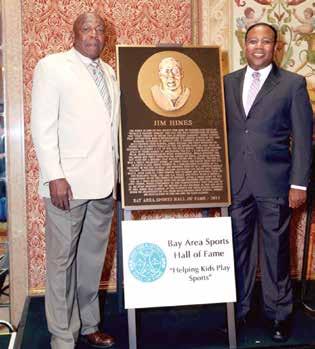
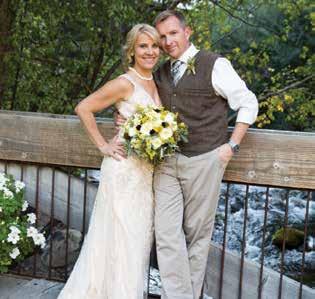
1. From left to right: Jim Hines, double gold medalist (track & field, 1968) accepts his Bay Area Sports Hall of Fame honor on May 7, 2014 at the Westin St. Francis Hotel. His son, Jim Hines, Jr. was also in attendance.
2. From left to right: Erinn Smart (fencing, 2004, 2008), Ivan Lee (fencing, 2004) and Keeth Smart (fencing, 2000, 2004, 2008) were honored on June 27th as the latest inductees into the USA Fencing Hall of Fame.

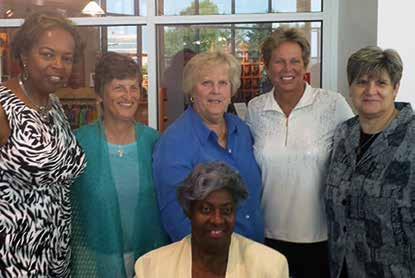
3. Tracy Evans (freestyle skiing, 1994, 1998, 2002) and Michael Land tie the knot at Sundance Resort in Sundance, Utah on September 6, 2014.
4. 1976 Women’s Olympic Basketball team honored at the Women’s Basketball Hall of Fame
From left to right: Gail Marquis, Sue Rojcewicz, Head Coach Billie Moore, Ann Meyers-Drysdale and Juliene Simpson. Seated in the front: Lusia HarrisStewart.
THE OLYMPIAN NEWSLETTER 23
2 3 4 1
UNITED STATES OLYMPIC COMMITTEE BOARD OF DIRECTORS
USOC CHAIRMAN
Larry Probst
Robert Bach
James Benson
Scott A. Blackmun
Bob Bowlsby
Ursula M. Burns
Anita L. DeFrantz (rowing, 1976, 1980)
James L. Easton
John S. Hendricks
Nina Kemppel (cross-country skiing, 1992, 1994, 1998, 2002)
Susanne Lyons
Bill Marolt (alpine skiing, 1964)
Mary McCagg (rowing, 1992, 1996)
Dave Ogrean
Whitney Ping (table tennis, 2004)
Angela Ruggiero (ice hockey,1998, 2002, 2006, 2010)
USOC CHIEF EXECUTIVE OFFICER
Scott A. Blackmun
U.S. OLYMPIANS & PARALYMPIANS OFFICERS 2013-16
PRESIDENT
Gary Hall, Sr. (swimming, 1968, 1972, 1976)
VICE PRESIDENTS
Carol Brown (rowing, 1976, 1980, 1984)
Joey Cheek (speedskating, 2002, 2006)
Dick Fosbury (track & field, 1968)
Micki King (diving, 1968, 1972)
Carol Lewis Zilli (track & field, 1984, 1988)
Greg Louganis (diving, 1976, 1980, 1984, 1988)
Eli A. Wolff (Paralympic soccer, 1996, 2004)
IMMEDIATE PAST PRESIDENT
Willie Banks (track & field, 1980, 1984, 1988)
PAST PRESIDENTS
John Naber (swimming, 1976)
Bill Toomey (track & field, 1968)
EDITORIAL STAFF
SENIOR EDITOR
Cynthia E. Stinger (team handball, 1984, 1988, 1992)
ASSOCIATE EDITOR
Christine Taylor
PRODUCTION DIRECTOR
O’Shea Design
Photos
U.S. OLYMPIANS & PARALYMPIANS CHAPTERS
Alabama Olympians & Paralympians
President: Jennifer Chandler Stevenson (diving, 1976) (205) 313-7436
Arizona Olympians & Paralympians
Presiding Officer: Misty Hyman (swimming, 2000) (650) 248-6359
Colorado Olympians & Paralympians
Presiding Officer: Gene Kotlarek (ski jumping 1960, 1964) (303) 807-3911
Florida Olympians
President: Carrie Zimmerman (gymnastics, 1976) (850) 212-7846
Georgia Olympians & Paralympians
President: Bob Pickens (wrestling, 1964) (773) 425-3254
Hawaii Olympians
President: Kathy Hammond Lohman (track & field, 1972) (808) 395-2446
Houston Olympians & Paralympians
President: Jacqueline Washington (track & field, 1984) (832) 488-8573
Idaho Olympians & Paralympians
President: Dick Fosbury (track & field, 1968) (208) 720-2352
Indiana Olympians
President: Ollan Cassell (track & field, 1964) (317) 466-0444
Michigan Olympians & Paralympians
President: Judi Brown Clarke (track & field, 1984) (517) 881-6710
Midwest Olympians & Paralympians
President: Diane Simpson (rhythmic gymnastics, 1988) (847) 452-7843
Missouri/Illinois Olympians & Paralympians
President: John Carenza (soccer, 1972) (314) 846-4124
National Capital Area Olympians
President: Arlene Limas (taekwondo, 1988) (540) 720-1988
Nevada Olympians & Paralympians
President: Dean Willeford (water polo, 1968) (775) 827-1775
New England Area Olympians & Paralympians
President: Sharon Ann Jewell (taekwondo, 1988) (404) 668-7896
New Mexico Olympians & Paralympians
President: Trent Dimas (gymnastics, 1992) (505) 850-2956
Northern California Olympians
President: Greg Massialas (fencing, 1980, 1984, 1988) (415) 441-0521
Oregon Olympians & Paralympians
President: Lisa Kosglow (snowboarding, 1998, 2002) (541) 400-9061
Southern California Olympians
President: Tamara Christopherson (canoe/kayak, 2000) (206) 605-9265
Southwest Olympians & Paralympians
President: Sammy Walker (weightlifting, 1976) (469) 955-3158
Tri-States Olympians
President: Diane Dixon (track & field, 1984, 1988) (917) 538-3195
Utah Olympians
President: Debra Stark (gymnastics, 1972) (801) 369-9918
Washington Olympians
President: John Stillings (rowing, 1984) (206) 440-0708
Western PA-OH-WV Olympians
President: Julie Koons (speedskating, 2002) (216) 346-2650
No chapter in your area?
Interested in starting a chapter?
Contact the U.S. Olympians & Paralympians Association office for details at: (800) 717-7555
www.teamusa.org 24 THE OLYMPIAN NEWSLETTER
by: getty Images, USOC Archives and other sources





 Paul Gonzales Jr., of the U.S. stands above silver medalist Salvatore Todisco of Italy on the podium and celebrates winning the men’s light-flyweight boxing final on Aug. 11, 1984, during the XXIII Olympic Games at the Los Angeles Memorial Sports Arena in Los Angeles.
Carl Lewis of the U.S. raises his arms aloft as he crosses the line to anchor the U.S. team to victory in the 4x100-meter during the Los Angeles 1984 Olympic Games at the coliseum on Aug. 11, 1984.
Paul Gonzales Jr., of the U.S. stands above silver medalist Salvatore Todisco of Italy on the podium and celebrates winning the men’s light-flyweight boxing final on Aug. 11, 1984, during the XXIII Olympic Games at the Los Angeles Memorial Sports Arena in Los Angeles.
Carl Lewis of the U.S. raises his arms aloft as he crosses the line to anchor the U.S. team to victory in the 4x100-meter during the Los Angeles 1984 Olympic Games at the coliseum on Aug. 11, 1984.
















































